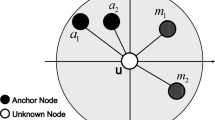Abstract
Most of the state-of-the-art localization algorithms in wireless sensor networks (WSNs) are vulnerable to various kinds of location attacks, whereas secure localization schemes proposed so far are too complex to apply to power constrainedWSNs. This paper provides a distributed robust localization algorithm called Bilateration that employs a unified way to deal with all kinds of location attacks as well as other kinds of information distortion caused by node malfunction or abnormal environmental noise. Bilateration directly calculates two candidate positions for every two heard anchors, and then uses the average of a maximum set of close-by candidate positions as the location estimation. The basic idea behind Bilateration is that candidate positions calculated from reasonable (i.e., error bounded) anchor positions and distance measurements tend to be close to each other, whereas candidate positions calculated from false anchor positions or distance measurements are highly unlikely to be close to each other if false information are not collaborated. By using ilateration instead of classical multilateration to compute location estimation, Bilateration requires much lower computational complexity, yet still retains the same localization accuracy. This paper also evaluates and compares Bilateration with three multilateration-based localization algorithms, and the simulation results show that Bilateration achieves the best comprehensive performance and is more suitable to real wireless sensor networks.
Similar content being viewed by others
Explore related subjects
Discover the latest articles and news from researchers in related subjects, suggested using machine learning.References
Niculescu D, Nath B. Ad hoc positioning system (APS). In: Proceedings of the IEEE Global Communications Conference of GLOBECOM. San Antonio: IEEE Computer Society, 2001, 2926–2931
Bulusu N, Heidemann J, Estrin D. GPS-less low cost outdoor localization for very small devices. IEEE Personal Communications Magazine, 2000, 7(5): 28–34
He T, Huang C. Range-free localization schemes for large scale sensor networks. In: Proceedings of the 9th annual international conference on Mobile computing and networking. San Diego: ACM, 2003, 81–95
Niculescu D, Nath B. DV based positioning in ad hoc networks. Journal of Telecommunication Systems, 2003, 22(1–4): 267–280
Nagpal R, et al. Organizing a global coordinate system from local information on an ad hoc sensor network. In: Proceedings of 2nd International Workshop on IPSN. Berlin: Springer, 2003, 333–348
Doherty L, Pister K. Convex position estimation in wireless sensor networks. In: Proceedings of 20th Annual Joint Conference of the IEEE Computer and Communications Societies. Anchorage, AK, USA: IEEE, 2001, 1655–1663
Bahl P, Padmanabhan V N. RADAR: an in-building RFbased user location and tracking system. In: Proceedings of 19th Annual Joint Conference of the IEEE Computer and Communications Societies. Tel-Aviv, Israel: IEEE Computer Society, 2000, 775–784
Niculescu D, NatB h. Ad hoc positioning system (APS) using AOA. In: Proceedings of 22 Annual Joint Conference of the IEEE Computer and Communications Societies. San Francisco, CA: IEEE Press, 2003, 1734–1743
Lymberopoulos D, Lindsey Q. An Empirical Analysis of Radio Signal Strength Variability in IEEE 802.15.4 Networks using Monopole Antennas. ENALAB Technical Report 050501. Yale University, 2006
Xu W, Wood T, Trappe W, et al. Channel surfing and spatial retreats: defenses against wireless denial of service. In: Proceedings of the ACM workshop on Wireless security. Philadelphia, PA, USA: ACM, 2004, 80–89
Hu Y C, Perrig A, Johnson D. Packet leashes: a defense against wormhole attacks in wireless networks. In: 22 Annual Joint Conference of the IEEE Computer and Communications Societies. San Francisco, CA: IEEE, 2003, 1976–1986
Brands S, Chaum D. Distance-bounding protocols. In: Workshop on the theory and application of cryptographic techniques on Advances in cryptology. New York: Springer-Verlag, 1993, 344–359
Sastry N, Shankar U, Wagner D. Secure verification of location claims. In: Proceedings of the 2nd ACM workshop on Wireless security. San Diego, CA, USA: ACM, 2003, 1–10
Waters B, Felten E. Proving the Location of Tamper Resistant Devices. Technical Report. Princeton University, 2003
Čapkun S, Buttyăn L, Hubaux J P. SECTOR: Secure tracking of node encounters in multi-hop wireless networks. In: Proceedings of the 1st ACM workshop on Security of ad hoc and sensor networks. Fairfax, Virginia: ACM, 2003, 21–32
Tao P, Rudys A, Ladd A M, et al. Wireless lan location-sensing for security applications. In: Proceedings of the ACM Workshop on Wireless Security. New York, NY, USA: ACM, 2003, 11–20
Li Z, Trappe W, Zhang Y Y, et al. Robust statistical methods for securing wireless localization in sensor networks. In: Proceedings of Information Processing in Sensor Networks. Piscataway, NJ, USA: IEEE, 2005, 91–98
Gabber E, Wool A. How to prove where you are: tracking the location of customer equipment. In: Proceedings of Conference on Computer and Communications Security. New York, NY, USA: ACM, 1998, 142–149
Lazos L, Poovendran R. SeRLoc: Secure range-independent localization for wireless sensor networks. In: Proceedings of the 2004 ACM Workshop on Wireless Security. New York, NY, USA: ACM, 2004, 21–30
Kuhn M G. An asymmetric security mechanism for navigation signals. In: Proceedings of the Information Hiding Workshop. Berlin: Springer, 2004, 239–252
Liu D, Ning P, Du W. Attack-resistant location estimation in sensor networks. In: Proceedings of Information Processing in Sensor Networks. UCLALos Angeles, California, USA: IEEE, 2005, 99–106
Moore D, Leonard J, Rus D, et al. Robust distributed network localization with noisy range measurements. In: Proceedings of the Second ACM Conference on Embedded Networked Sensor Systems. New York, NY, USA: ACM, 2004, 50–61
Przydatek B, Song D, Perrig A. SIA: Secure information aggregation in sensor networks. In: Proceedings of the 1st International Conference on Embedded Networked Sensor Systems. New York, NY, USA: ACM, 2003, 255–265
Wagner D. Resilient aggregation in sensor networks. In: Proceedings of the 2nd ACM workshop on Security of ad hoc and sensor networks. New York, NY, USA: ACM, 2004, 78–87
Author information
Authors and Affiliations
Corresponding author
Rights and permissions
About this article
Cite this article
Li, X., Hua, B., Shang, Y. et al. A robust localization algorithm in wireless sensor networks. Front. Comput. Sci. China 2, 438–450 (2008). https://doi.org/10.1007/s11704-008-0018-7
Received:
Accepted:
Published:
Issue Date:
DOI: https://doi.org/10.1007/s11704-008-0018-7




